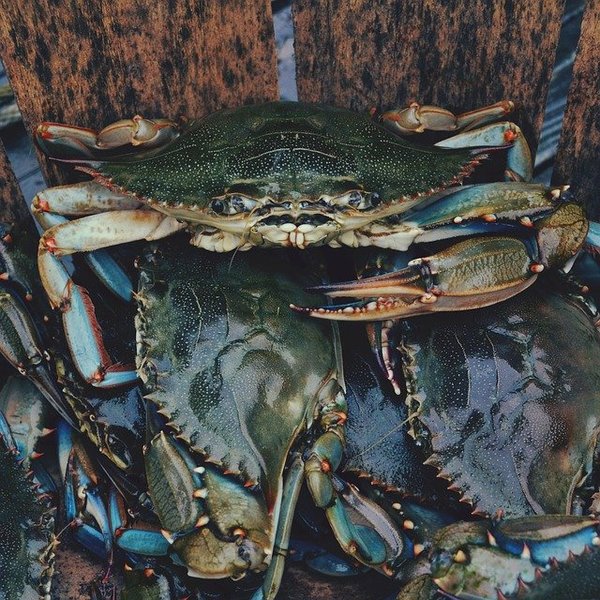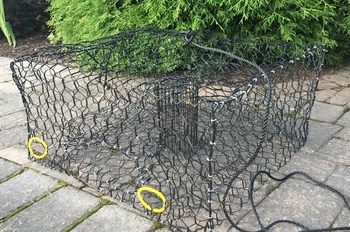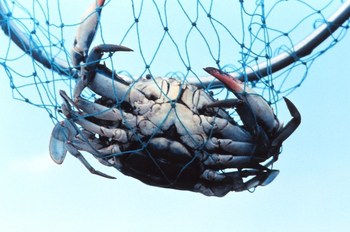Here Are 20 Things You Should Always Bring To A Crabbing Trip
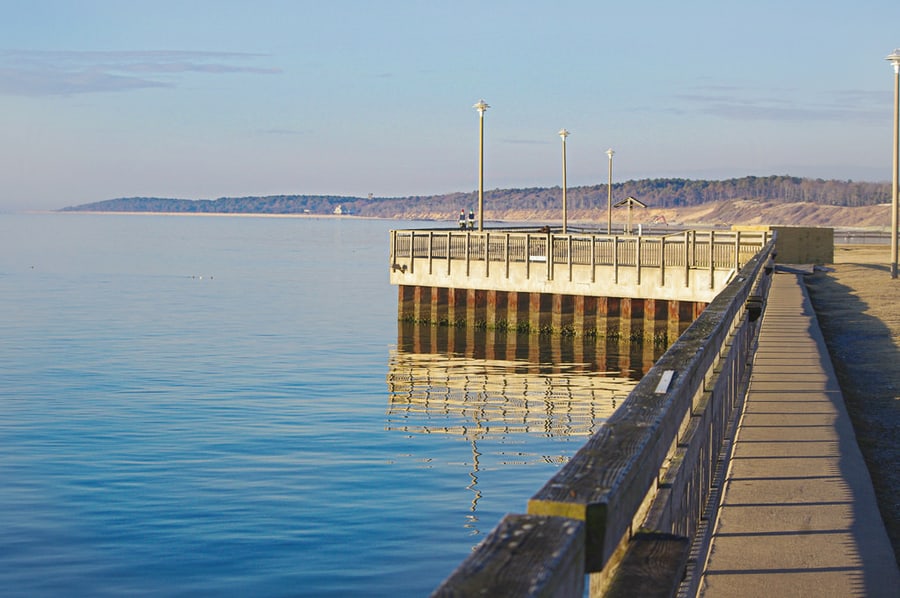
Many beginner crabbers ask the important question: what do I need to go crabbing? I was so surprised to find that there was not an article on the subject!
The fill the void, I came up with a list of 20 items you absolutely need to go crabbing, including a few essentials that the other “Crabbing Guides” don’t tell you about.
Just thought this would be helpful to any of you beginner crabbers out there. Enjoy the post.
Crabbing Barebone Essentials
Whether you are crabbing from a boat, the shoreline, or off a pier, each item in this section will come in handy. I was going to label this section as “General” but I guess you could call them “Barebone Essentials.”
Tongs, Thick Gloves, or Both!
I could never take any of my squeamish friends crabbing. They were always afraid of getting pinched! Let me tell you, getting pinched is no fun. A smart way to avoid it is to bring tongs or thick gloves on your crabbing trip.
A pair of kitchen tongs will do just fine. Just keep in mind you’ll have to thoroughly wash it afterward as crabs carry a lot of bacteria. Personally, I’ve found that tongs with rubber ends have a better grip on slippery blue crabs. You want to pick up the crab from behind with its body gripped between the tongs.
The longer the pair of tongs the better. I would recommend a 12″ pair of tongs, like this one I found on Amazon.com (Affiliate Link). It’s inexpensive yet well made.
A better option for handling crabs, in my opinion, is a thick pair of crabbing gloves. It’s much easier to handle crabs with your hands rather than a pair of tongs. If you’re someone who isn’t afraid of getting pinched but would still like to avoid the pain, I recommend some crabbing gloves.
I have a friend who works on crabbing boats for the summer. He never leaves the harbor without a pair of Promar ProGrip Gloves (Affiliate Link). You can barely feel the sharp pinch with these gloves on. Also, they’ll last a pretty long time. My friend needs a new pair every other season, and that’s after long days of handling crabs throughout most of the summer!
A Bushel Basket

No one realizes how useful the bushel basket is until they try one out for themselves. It works as both a measuring device for how many crabs you’ve caught and a way of preserving your crabs while they’re out of the water. Let me explain.
After writing articles on each state’s crabbing regulations, I’ve found time and time again that daily catch limits are measured by the bushel. How are you supposed to know that you’ve caught a bushel if you aren’t using a bushel basket? I guess you could count until you hit 84 crabs (the average amount of crabs in a bushel), but that varies when you factor in the size and sex of each crab caught.
A DNR officer will ticket you in a heartbeat if he feels you have gone over your daily catch limit. The only way you can prove him wrong is with a bushel basket.
You can sometimes find these baskets used at crab shacks, but they’re usually falling apart and rotting. I recommend picking up a new one from Amazon.com (Affiliate Link).
If used right, these baskets can also serve as a way to keep your crabs alive out of water. All you need is an old towel or some burlap.
Let’s assume you brought a towel. After your crabs are in your bushel basket, dip the towel in the water, and cover the basket. Next, move it to a shady spot. It’s a trick old-time crabbers took advantage of to keep their catch alive until they reach the dock.
A Crab Gauge or Measuring Stick
Another thing I’ve learned after researching each coastal state’s crabbing regulations is that you can only keep crabs of a certain size. Blue crabs are measured by the distance between each end of the longest point on the crab’s carapace (top shell). See the image below:
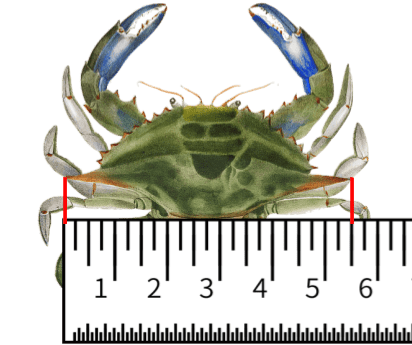
To make sure each crab you catch is above the minimum measurement for your state, you will need a crab gauge or some sort of measuring stick.
If you want a recommendation, crab gauges are a bit easier to use. They are shaped like a C, so all you need to do is check if the crab fits inside the C. If it does, throw it back it’s too small. Otherwise, the crab’s outermost points will be too large to fit in the C, which means it’s a keeper.
The only issue with crab gauges is that they only make them for states on the west coast. If you live there, here’s the lowest price crab gauge I could find on Amazon (Affiliate Link).
If you’re from the East Coast like me, you have to make do with a ruler. I mark my ruler at the 5″ mark (the minimum size for hardshell blue crabs in Delaware & Maryland). I’ve seen some crabbers pull off a make-shift crab gauge. All you need to do is hot glue popsicle sticks at the 0″ and 5″ marks on your ruler.
Bait & A Knife
This is easily one of the most important items on this list. The kind of bait your use can make or break your crabbing trip. Check out my article: The Best Crab Bait in 2020 to find out what kind of bait you should use.
I could go on all day comparing popular crab baits. That’s what my crab bait article is for. Here, I want to talk about a knife. Every time I go crabbing, I bring a knife to cut whatever bait I decide to use for that trip. This helps me divide the bait among each of my traps.
I don’t use anything special. Personally, I use an old buck knife my grandparents gave me a few years back. It’s served me quite well over the years and does a great job. I managed to find it on Amazon.com (affiliate link).
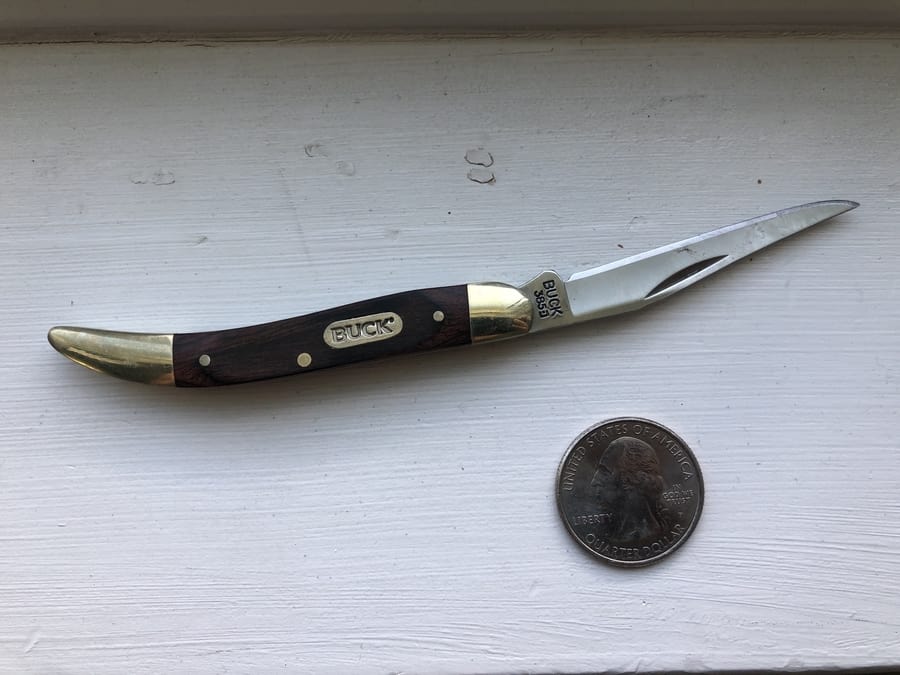
As you can tell from the picture, it’s a bit small. Not everyone’s a fan of that, but I think it’s perfect. It fits right into my pocket and does a great job cutting fish, chicken, or whatever else you use for bait.
A Dip Net
You always take a dip net fishing, why wouldn’t you take it with you crabbing? A dip net always comes in handy on my crabbing trips, especially if you plan to use handlines.
You’d be surprised how often you need to scoop something out of the water. while crabbing. There’s no better tool for the job than the dip net. It’s apart of the essential crabber toolbox, which puts it on this list.
You can find a dip net at any bait & tackle shop, general outdoor retail store, or Amazon. Here’s a fairly-priced dip net I found on Amazon.com (Affiliate Link).
A Cooler with Ice
You’ll absolutely need a cooler with some ice. Without one, you risk losing your catch! Live crabs can last 48 hours while on ice, the best way to go about that is with a cooler.
You need a rather large cooler (depending on how many crabs you’re handing). A 120 qt cooler will fit an entire bushel. Here’s one that I use on Amazon.com (Affiliate Link). It’s large enough to evenly place crabs across the cooler. Stacking them on top of one another can cause stress, which either ruins the quality of the meat or kills the crabs.
I explain how to properly store live crabs in my article: How to Keep Crabs Alive and Well. Be sure to check it out!
Trap Necessities
Now that we got the more general crabbing items out the way, let’s get into the bread and butter of crabbing: your traps.
Your Preferred Crab Trap
Ok, I know this one is obvious. Of course, you’re going to bring a crab trap to go crabbing. I only mention it because it’s a complete necessity.
As a recreational crabber, you have a few options when it comes to crab traps. A few options include:
- Handlines & Dip Nets
- Collapsible Traps
- Crab Pots
- Trotline
Check out my recommended gear page for more information on each of these traps.
A Buoy (IMPORTANT)
Stop what you’re doing! I need you to pay attention. Don’t you dare go crabbing without a buoy. I’ve seen it happen too many times… Someone goes crabbing without the correct buoy and gets a several hundred dollar fine.
Each state has its own set of rules when it comes to recreational crab trap buoy guidelines. Be sure to check with your local DNR office to find your state’s rules. Most often, it’s required that recreational crabbing buoys need to be all white. Some states require that you write your name and home address on the buoy, others require a large ‘R’ which stands for Recreational.
Nevertheless, you’re going to need a buoy. Again, check your local crabbing regulations for the correct buoy you need. From there, you can buy one at your local bait and tackle shop, outdoor retail store, or online.
Weighted Line
Next up on our list is weighted line. If you’re nothing this for your crab pots, whats the matter with you?
Weighted line is much, much better than regular rope. Not only is it durable, but it also sinks! If you’ve never gone crabbing before, you probably don’t understand how big of a deal this is.
A rope that floats at the surface above your crab pot can get caught in boat motors. If your rope gets snagged by an unsuspecting boat, say goodbye! You won’t see that trap again. There goes a perfectly good crab trap.
You can avoid this by investing in a weighted line. Usually, you find the best weighted line at bait & tackle shops, but sometimes you can find high-quality rope on Amazon like the KUFA sinking line (Affiliate Link).
Weights For Your Traps

Let me tell you a story about the crabber who thought he could get away with no weight on his crab pot. His trap ended up a quarter mile down the river. He’s lucky he spotted it on his way where he originally set it. Of course, it was empty after being knocked around in the unforgiving current.
Surprise! That crabber was me. ALWAYS weigh your crab pots, especially when crabbing in strong currents.
You have a few options to add weight to your traps. If you’re using crab pots, I recommend securing some rebar to the bottom of your pot with zip ties. This can get a bit too DIY for some, but I can testify that this does a great job.
If you’re using collapsible traps or crabbing in calmer waters, you can add pyramid sinkers to the bottom of your trap. I recommend one on each corner for rougher waters or a single weight in the center for calmer waters. Shrimpy Joe carries the heaviest pyramid sinkers for the lowest price, click here to check him out on Amazon (Affiliate Link).
A Bait Cage
If you’re crabbing on the West Coast, you’re going to need a bait cage. As an East Coast crabber, I don’t know how you people do it! Not only do Dungeness crabs have twice the cage-crushing power of a blue crab, but you also have to deal with seals and sea lions stealing your bait.
There’s two ways to deal with that.
One, get a stronger trap. If you want a recommendation I have an article on the Best Trap for Dungeness Crabs. Feel free to check that out.
To tackle the issue of your bait getting stolen, you need to pick up a bait cage. I’ve never needed one personally, but if I were to pick one it would be Danielson’s bait cage (Affiliate Link). There are varying reviews but this model has far fewer negative reviews than its competitors.
This is a bit out of my expertise. What’s your favorite bait cage? Let me know in the comments.
Extra Helpful Items
The following items are not essential whatsoever. Nonetheless, I always bring them with me while out on the water. Every once in a while they come in handy and make my crabbing trip that much better.
A Cast Throw Net
A cast throw net? Yeah! What better way is there to catch some fresh bait? There is no better feeling than using fish you caught to bait your crab traps. You’re saving money that would be spent on smelly bait, and fresher bait ALWAYS catches more crabs.
Betts Old Salt Premium Cast Net (Affiliate Link).
A 5-gallon bucket
Come on! You can’t go crabbing without a bucket!
What if you need somewhere to place your bait? Set aside a crab while your hands are full? It’s solely for convenience. It’s one of those things that you don’t know you need until you need it. So, get ahead of the curb. Bring a 5-gallon bucket to your next crabbing trip.
You can get these anywhere. Personally, I get mine from Home Depot because it’s the closest. Believe it or not, they sell Home Depot 5 Gal Buckets on Amazon (Affiliate Link). Throw it in with your shopping cart because why not!
Personal Items People Often Forget
With all this crabbing gear confusion, it’s easy to forget that you are spending a day out on the river or bay. You’re going to need the necessities:
- SUNSCREEN
- BUG SPRAY
- Closed-toed shoes
- A fold-up chair
- Snacks & water
- Clothes you don’t mind getting dirty
- A good book
- A sun hat
- Sunglasses
Don’t worry about getting carried away with this part. If there’s something you don’t need, just leave it in your car.
But wait! I’m begging you to bring bug spray and sunscreen. Without either, this will be a nasty crabbing trip.

